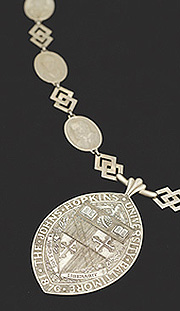The Presidential Insignia

On Commencement Day, President
William R. Brody will wear the presidential insignia, a
silver necklace that holds the Johns Hopkins seal, right,
and a medallion for each of the university's presidents.
Brody's portrait is shown below at left.
Photos by Will Kirk / HIPS
|
By Greg RienziThe Gazette
On Commencement Day 1966, the university's eighth
president, Milton S. Eisenhower, added a
rather conspicuous accessory to his academic regalia, one
that had been created to help him and
future presidents stand out in the crowd.
That year, Eisenhower first wore the Johns Hopkins
presidential insignia, a long and hefty
sterling silver necklace that signifies the authority
vested in the president by the board of trustees.
The tradition of academic ornamental jewelry dates
back to the Middle Ages in Europe and was
brought to JHU to add a touch of pageantry and regality to
university ceremonies.
The insignia, crafted by local silversmith Henry
Powell Hopkins Jr. (who believes he is a distant
relative of the university's founder), features a Johns
Hopkins seal pendant, chain links and 20
medallions, on 13 of which are portraits of each of the
university presidents. Seven medallions are
blank, awaiting likenesses of future presidents.
Two other local artists, Bill Heymann and Frank Hill,
engraved the portraits, basing the images
on photographs provided by the university. The reverse side
of the portraits contains the president's
name and years in office.
Hopkins, who with his son, Henry III, and daughter,
Martha, still owns and operates Henry P.
Hopkins Silversmiths in Baltimore, estimates that the
insignia cost $5,000 to make and took nearly a
year to craft. The trick, he says, was designing the exact
length of links between the engraved
medallions so that the necklace would drape properly over
an academic robe and fall on the wearer's
sternum. Hopkins says that the piece had to be reworked
several times before it fell just right on
Eisenhower, a man of modest height.
Hopkins had in 1954 crafted the university's mace,
which is carried by the chief marshal during
the commencement procession, and carried and displayed at
presidential inaugurations. Hopkins
Silversmiths also designed the ceremonial necklace worn by
Edward Miller, dean of the medical faculty
and CEO of Johns Hopkins Medicine, and the maces in use at
Washington College, Loyola College, the
University of Pennsylvania and several other colleges and
universities.
"But Johns Hopkins was one of our first big jobs,"
Hopkins said. "It really put us on the map."
 GO TO MAY 19, 2008
TABLE OF CONTENTS.
GO TO MAY 19, 2008
TABLE OF CONTENTS.
 GO TO THE GAZETTE
FRONT PAGE.
GO TO THE GAZETTE
FRONT PAGE.
|